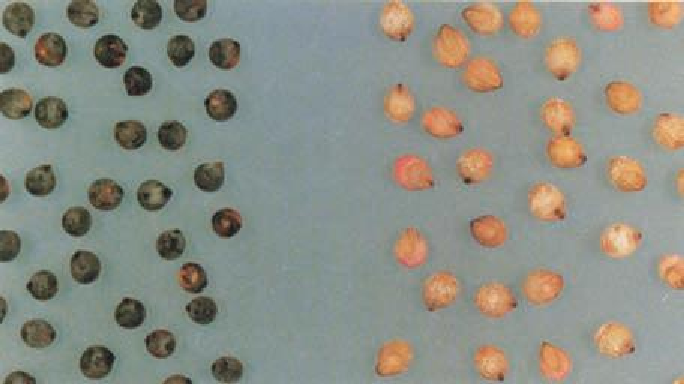Agriculture Reference
In-Depth Information
Procedure
1. Prepare a 1:5 (wt:vol) solution of potassium hydroxide (KOH) and fresh household bleach (5.25%
NaOCl) by adding 1.0 g of potassium hydroxide and 5.0 ml of bleach to 100 ml of H
2
O. The
bleach and KOH-bleach solutions should be kept refrigerated.
2. Put the seeds into a glass container and completely cover with the KOH-bleach solution which
was irst adjusted to room temperature.
3. Soak seeds with brown seed coats for 10 min and those with white seed coats for 5 min in the
KOH-bleach solution. Gently swirl the mixture periodically.
4. Place seeds in a sieve and gently rinse with tap water.
5. Place rinsed seeds on a paper towel and allow to air dry. Do not pat the seeds dry since this may
remove the pigment.
6. After drying, record the results as number of dark and light seeds (Fig. 9.13).
Figure 9.13. The potassium hydroxide (KOH) test for sorghum: dark seeds (left), light seeds (right).
Sodium Hydroxide (naoH) Test for Wheat
(
Triticum aestivum
)
It is often dificult to distinguish red and white varieties of wheat, especially if they have been treated with a
fungicide. They may also be dificult to distinguish if weather-damage has occurred in the ield. The NaOH
test should be useful to help in this distinction. Light color is white wheat and dark color is red wheat.
After soaking, white varieties will have a light cream color, while red varieties become more red in color. If
NaOH is unavailable, a 1% solution of KOH can be used instead (Chemlar and Mostovoj, 1938).
Procedure
1. Separate 400 seeds or more from the pure seed sample.
2. Wash in 95% methyl alcohol for 15 min.
3. Dry for 30 min.
4. Soak in a 5.0 N NaOH solution for 2 min at room temperature.
5. Place seeds in an uncovered petri dish and dry at room temperature.
6. Separate and count the seeds in light or dark color categories (Fig. 9.14). Record your results.

